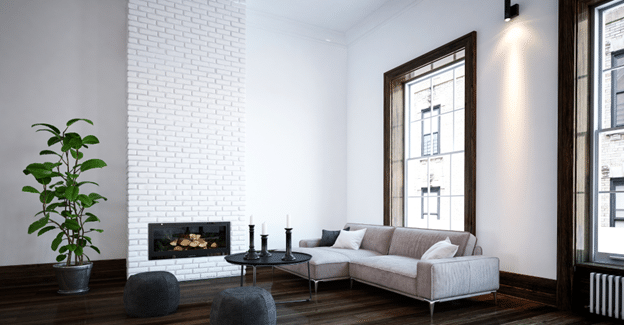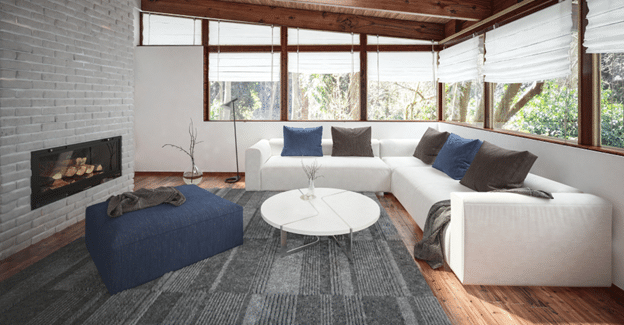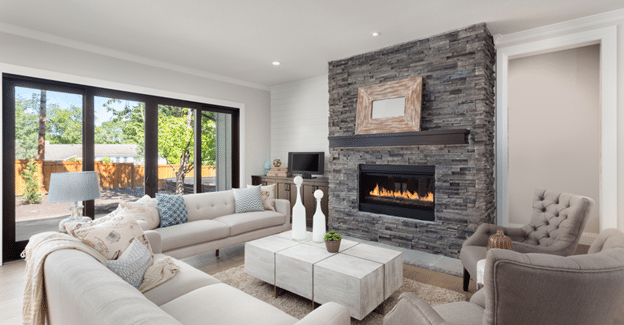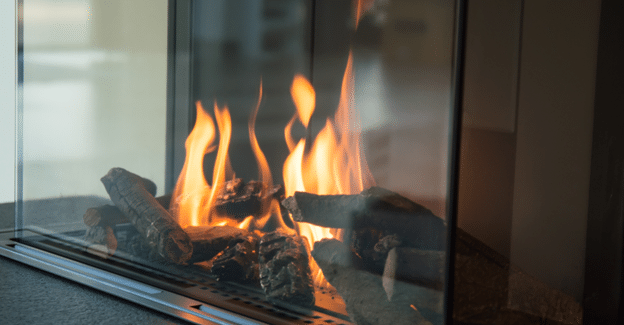Imagine stepping into a room, and instead of the usual chill that greets you during those cold months, warmth wraps around you like a cozy blanket thanks to the beautiful fireplace.
Gone are the days when fireplaces were mere decorative pieces or inefficient heat sources. Nowadays, they’re leading the pack when it comes to keeping your home warm without wasting energy.
The traditional fireplace has transformed so profoundly that missing out feels almost like leaving money on the table – especially when considering how much can be saved on energy bills. But how exactly does swapping open hearths for gas fireplace inserts make such a difference? And more intriguingly, what makes these newer models tick in terms of both efficiency and aesthetics?
Last winter’s energy bill probably still haunts your dreams. Let me tell you: there’s hope yet for cozier winters without breaking the bank.
Understanding Fireplace Energy Efficiency
When it comes to staying warm and cozy, nothing quite beats the ambiance of a crackling fireplace. But here’s the thing – traditional fireplaces? They’re not exactly winning any awards in the efficiency department.
Those old-school masonries and wood-burning setups can be wasteful, letting precious heat escape up the chimney faster than you can say, “pass the marshmallows.” So, let’s dive into the nitty-gritty of fireplace energy efficiency and explore how we can keep our homes toasty without breaking the bank or doing a number on the environment.
The Efficiency Challenge with Traditional Fireplaces
Picture this: you’ve got a classic brick fireplace that’s been around since your grandparents’ day. It’s charming, rustic, and… hemorrhaging heat like there’s no tomorrow. Studies show that traditional masonry fireplaces can have efficiency ratings as low as 10%, meaning 90% of the heat generated goes straight up and out.
Wood-burning fireplaces aren’t much better. Sure, there’s something undeniably primal about throwing a log on the fire, but when it comes to heating your home? Let’s just say you might as well be tossing dollar bills into the flames. The U.S. Department of Energy reports that traditional wood-burning fireplaces are only about 15% efficient at best.
Fuel Use and Environmental Impact
Now, let’s talk about fuel. The type of fuel you use in your fireplace doesn’t just affect your wallet; it also has a big impact on the planet. Wood-burning fireplaces, for instance, release particulate matter and other pollutants into the air, contributing to poor air quality both inside and outside your home.
On the other hand, gas fireplaces burn cleaner and produce fewer emissions. But here’s the catch – they still rely on fossil fuels, which come with their own environmental baggage. And let’s not forget about the methane leaks that can happen during natural gas extraction and transportation.
So, what’s an eco-conscious, heat-seeking homeowner to do? Fear not, my friends. So, we’re in luck because many cool new options around the corner promise to let us enjoy our fireplaces without losing out on warmth.
Innovative Solutions for Fireplace Efficiency
We’ve established that traditional fireplaces aren’t exactly winning any efficiency awards. But before you rip out your hearth in despair, hear me out. Some seriously cool upgrades can transform your fireplace from an energy hog to a heat-generating powerhouse.
The Role of Fireplace Inserts
First up, let’s talk about fireplace inserts. These bad boys are like the superhero capes of the fireplace world, swooping in to save the day (and your energy bills). An insert is a sealed combustion box that fits snugly into your existing fireplace, dramatically boosting efficiency and heat output.
Take wood inserts, for example. Unlike traditional wood-burning fireplaces, these inserts feature airtight doors and advanced combustion technology that can bump efficiency ratings up to a whopping 80%. That means more heat stays in your living room, not up the chimney.
Gas and electric inserts aren’t just hanging around; they’re big hitters for getting the most bang for your buck in heating. Gas inserts boast 70-90% efficiency ratings, while electric inserts can convert 100% of their energy into heat. And let’s not forget, with cool features like being able to adjust the temperature from wherever you are and managing it all from your couch, setting up your space just how you like, it has never been easier.
Benefits of Glass Fireplace Doors
Let’s talk about a simple but effective upgrade: glass fireplace doors. These transparent barriers do more than just add a sleek, modern touch to your hearth; they also work wonders for efficiency.
When you’ve got an open fireplace, all that lovely warm air you’ve generated is constantly battling with the cold air from the chimney. It’s like a never-ending tug-of-war, with your energy bills caught in the middle. However, installing glass doors creates a barrier that keeps the warm and cold air in.
Plus, glass doors help regulate airflow to the fire, allowing for more complete combustion and less smoke spillage into your living space. It’s a win-win: better efficiency and better indoor air quality. According to Bob Vila, adding glass doors to a wood-burning fireplace can boost efficiency by up to 20%.
Maximizing Heat Distribution in Your Home
Okay, you’ve upgraded your fireplace with a snazzy insert or sleek glass doors. Your efficiency game is on point, but how do you ensure all that glorious heat reaches every corner of your living space? Fear not, my friend. So, I’ve gathered many handy tips and clever strategies that I’m excited to share with you.
First things first, let’s talk about fans. No, not the kind you use to cool off in the summer. I’m talking about heat-circulating fans sitting on or near your fireplace, quietly working their magic to push all that toasty air into the room. Some inserts even come with built-in blowers that do the job for you.
But what if you don’t have a fan? No worries. You can still optimize heat distribution through strategic furniture placement. The key is to arrange your seating so it’s not blocking the flow of warm air from the fireplace. Avoid placing large pieces like sofas or bookshelves directly in front of the hearth, and instead, angle them to create a cozy, inviting space that allows heat to circulate freely.
Another pro tip? Keep your fireplace and chimney in tip-top shape with regular maintenance. A clean, well-maintained fireplace operates more efficiently and distributes heat more evenly. So, don’t neglect those annual chimney sweeps and inspections.
So, if you play your cards right and mix in some smart upgrades like sleek inserts or stylish glass doors, along with a dash of savvy when it comes to spreading that warmth around, you can turn what used to be an energy-hungry fireplace into the cozy, efficient heart of your home. And who knows? You might even find yourself looking forward to those chilly winter nights.
The Importance of Regular Maintenance
You might be surprised to learn that regular maintenance is a must if you want your fireplace to run efficiently and safely. It’s not just about the occasional dusting.
Chimney sweeping and fireplace repair are key. A professional chimney sweep will remove soot, creosote, and obstructions like bird nests. This helps prevent chimney fires and carbon monoxide leaks.
Fireplace repair is just as crucial. Over time, the heat can cause cracks in the firebox, damper, or flue. These need to be fixed ASAP to avoid bigger problems down the line.
The National Fire Protection Association recommends a chimney inspection at least once a year. A sweeping is needed for wood-burning fireplaces when there’s 1/8 inch of creosote buildup.
Gas fireplaces need love, too. An annual checkup will ensure the gas lines, pilot light, and ventilation are all working properly. At the end of the day, what matters is keeping your stress low and making sure everything runs smoothly.
So don’t neglect your fireplace – give it the TLC it deserves with regular maintenance. Your wallet (and your family’s safety) will thank you.
Technological Advancements in Fireplace Design
Fireplace technology has come a long way from the simple brick hearths of yesteryear. Nowadays, everyone focuses on designs that save time and money and give a nod to Mother Nature.
Take direct-vent gas fireplaces, for example. They use outside air for combustion and vent exhaust directly outside, which means no heat loss and no indoor air quality issues. Some models can even be controlled with a smartphone app.
And let’s not forget about electric fireplaces; they’re shaking things up in a big way. They don’t require venting and can be installed anywhere, making them perfect for apartments or homes without a chimney. Plus, they offer the ambiance of a real fire without the mess or maintenance.
Manufacturers also use advanced materials like ceramic glass and refractory cement to boost heat transfer and durability. And with 3D printing technology, the design possibilities are endless.
But it’s not just about looks – these advancements impact energy savings and the environment. High-efficiency fireplaces can have an AFUE rating of up to 90%, meaning less fuel consumption and lower heating costs.
So, if you’re in the market for a new fireplace, don’t be afraid to embrace the latest and greatest technology. Your home (and the planet) will be better for it.
Eco-Friendly Practices for Fireplace Use
As cozy as a crackling fire can be, it’s important to consider the environmental impact of your fireplace. But don’t worry – there are plenty of eco-friendly options out there.
One popular choice is bioethanol fuel. It’s made from renewable resources like sugarcane and corn and burns cleanly without smoke, soot, or ash. Bioethanol fireplaces don’t even need a chimney.
Wood pellets are another sustainable option. They’re made from compressed sawdust and other wood waste, so they recycle material that would otherwise end up in a landfill. Pellet stoves are highly efficient and produce very little air pollution.
Choose wood from sustainably managed forests if you prefer a traditional wood-burning fireplace. Hardwoods like oak and maple burn longer and produce less creosote than softwoods like pine.
Let’s not overlook the crucial role of keeping things in tip-top shape. A well-maintained fireplace will burn more efficiently and produce fewer emissions. That means regular sweeping and using a chimney cap to keep out debris.
By making smart fuel choices and practicing responsible fireplace use, you can enjoy all the benefits of a cozy fire without the guilt. Mother Nature will thank you.
Complementary Measures to Enhance Energy Savings
Fireplace inserts are a game-changer that makes your home more energy efficient. But they’re just one piece of the puzzle.
You can do many other things to reduce heating costs and make your home more comfortable. So, why don’t we dive right into some top picks?
First up, insulation. Imagine your home snuggled up in a cozy blanket, toasty warm on the inside while keeping the chill of winter firmly at bay. The better insulated your home is, the less energy you’ll need to keep it warm.
Next, consider investing in a programmable thermostat. These nifty devices let you set different temperatures for different times of the day, so you’re not wasting energy heating an empty house.
You can also make a big difference by sealing up any drafts around windows and doors. Just a bit of caulk and some weatherstripping can work wonders in keeping the heat from sneaking out.
And don’t forget about your windows themselves. Upgrading to energy-efficient windows can make a huge impact on your heating bills. They keep the warm and cold air in like a good pair of mittens.
Another often overlooked area is your water heater. Wrapping it in an insulating blanket and reducing the temperature slightly can save energy costs.
According to the U.S. Department of Energy, complementary energy-saving measures like insulation and programmable thermostats can reduce home heating costs by up to 30%.
So, while a fireplace insert is a fantastic start, don’t stop there. Combining it with energy-saving strategies can turn your home into a lean, green heat-trapping machine. Your wallet (and the planet) will thank you.
Conclusion
So, there you have it. Walking into a room perfectly warmed by an efficient fireplace isn’t just some cozy fantasy—it’s doable and can slash your energy bills big time. The journey from traditional to modern fireplaces is like moving from dial-up to broadband – a total game-changer in how we think about home heating.
We’ve navigated the ins and outs of fireplace efficiency, uncovering the truth behind those myths Hollywood loves to spin about anything innovative. Just like AI quietly revolutionizes our daily lives without noticing, smart fireplace solutions silently enhance our comfort and wallet thickness.
Last winter’s nightmares don’t stand a chance against today’s technology-driven warmth solutions. With every crackle and spark of your newly efficient setup, remember: So, it’s not just about keeping cozy; this is a chance to embrace change, slash those bills, and give Mother Earth a little love.
I’ve laid out everything – now it’s over to you. Warmth at less cost is possible and practical with these insights tucked under your belt. Remember, transforming your home into that snug haven doesn’t require magic, just knowledge, and action toward smarter fireplace efficiency.






